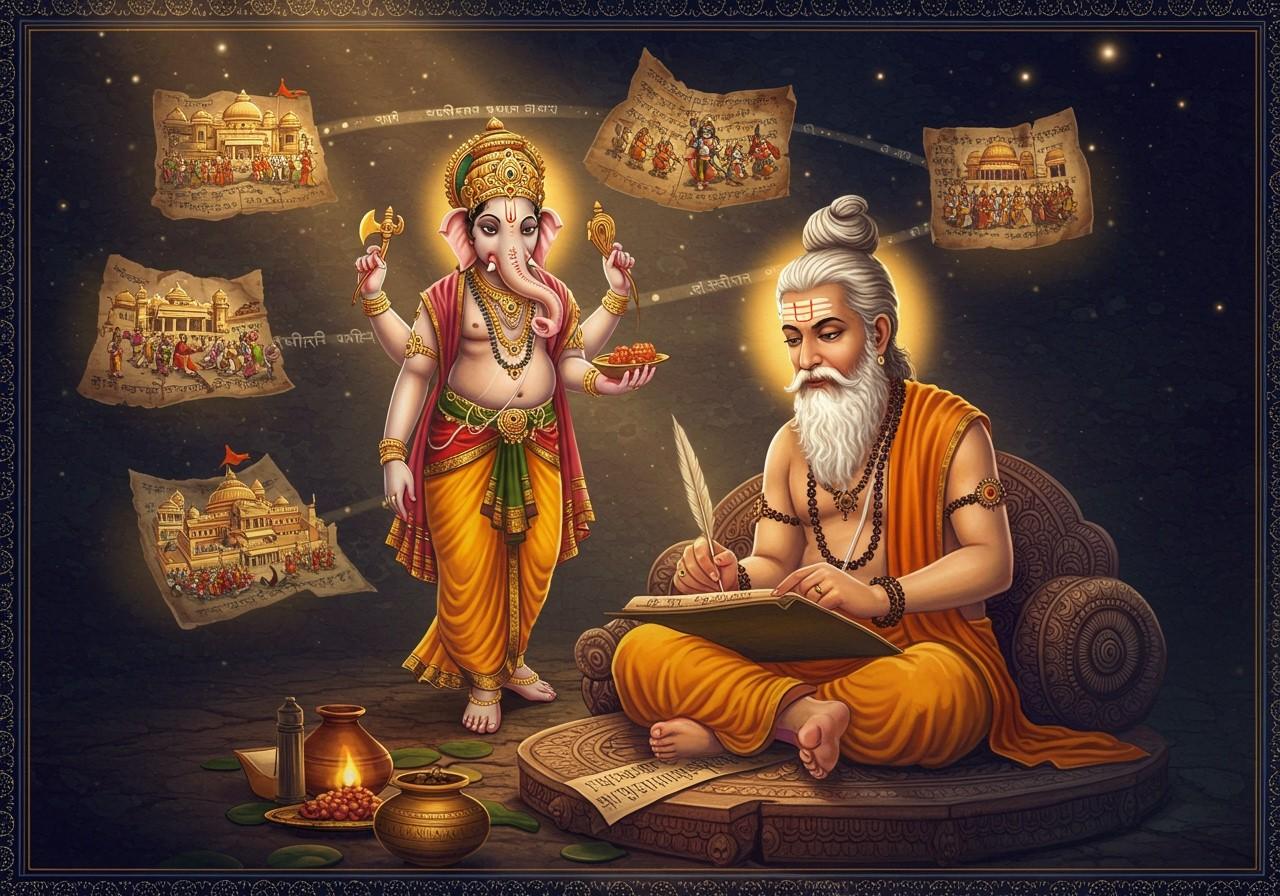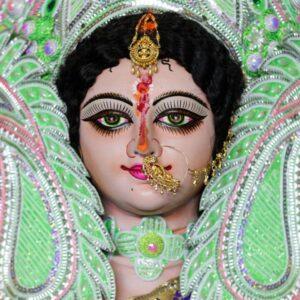
The Mahabharata, a cornerstone of Indian culture and a literary masterpiece, stands as one of the world’s greatest epics. Its intricate narratives, complex characters, and profound philosophical insights offer a rich exploration of moral and ethical dilemmas. This article delves into the origins, authorship, and historical context of the Mahabharata, providing a comprehensive understanding for those who cherish tradition and cultural heritage.
Origins of the Mahabharata
The Mahabharata’s journey began as an oral tradition, passed down through generations by spoken word. Sage Vyasa, credited with composing the epic, played a pivotal role in its creation. The epic’s evolution unfolded through three distinct phases: Jaya, Bharata, and finally, Mahabharata. Each phase expanded the narrative, weaving together mythology and historical events.
Geographical references within the text suggest its origins in North India. Influences from Vedic texts and earlier epics like the Ramayana are evident, enriching its narrative tapestry. Scholars believe the initial stories likely emerged between 900-800 BCE.
For a deeper dive into the diverse traditions within Hinduism, explore this insightful article: Hinduism’s Global Reach: A Look at Its Diverse Traditions.
Authorship of the Mahabharata
Vyasa, also known as Krishna Dvaipayana Vyasa, is revered as the legendary author. However, “Vyasa” is understood more as a title than the name of a single individual, suggesting multiple contributors over time. Legend has it that Lord Ganesha, the remover of obstacles, transcribed the epic as Vyasa narrated it.
Over the centuries, subsequent poets and scholars likely made additions and interpretations, leading to different versions of the text. Stylistic and linguistic variations within the epic point to multiple authorships. Professional bards, known as Sutas, played a crucial role in preserving and transmitting the epic through oral recitation. Scholars generally view the Mahabharata as a composite work, enriched by contributions from various sources over an extended period.
Discover more about the history and origin of Hinduism with this comprehensive resource: Hinduism: A Complete History and Origin. Also, consider exploring a concise history and origins in this article: Hinduism: A Concise History and Exploration of Its Origins.
Historical Context of the Mahabharata
The Mahabharata provides a glimpse into the socio-political landscape of ancient India, including the rise of the Kuru kingdom. Archaeological evidence from sites like Hastinapura and Kurukshetra offers tangible links to the events depicted in the epic. Dharma (duty/righteous conduct) plays a central role within this historical setting, shaping the actions and decisions of the characters.
The epic significantly influenced contemporary political structures and social norms, contributing to the perpetuation of the varna (caste) system and social hierarchy. While shrouded in mythology, significant figures like the Pandavas and Kauravas may have had real-life counterparts. The Mahabharata’s narrative integrates various cultural and regional influences, reflecting the diverse society of ancient India. It is considered a historical account and a text on dharma (moral law), compiled primarily between the 3rd century BCE and the 4th century CE.
Delve into the intriguing character of Ravana with this thought-provoking piece: Ravana Reexamined: A Scholar or a Villain? And for a deeper understanding of the epic’s author, explore: Valmiki Ramayana: Author, Poet, Sage.
Cultural Significance and Legacy
The Mahabharata’s impact on Indian culture and beyond is profound and enduring. It has shaped Indian philosophy through the Bhagavad Gita, a key philosophical and spiritual text embedded within the epic. The Mahabharata’s influence extends to Indian literature, arts, and performing traditions, including classical dance and theatre.
Adaptations in various regional languages and their cultural significance are immense. These retellings breathe new life into the epic, connecting generations with its timeless wisdom. In modern Indian society, the Mahabharata’s presence in popular media, such as television series and films, ensures its continued resonance with audiences across the country.
The epic’s moral and ethical teachings hold remarkable relevance even today. Concepts like dharma (duty/righteous conduct) offer invaluable guidance in navigating personal and professional life. The Mahabharata’s global influence is evident through translations and adaptations across various cultures, spreading its timeless wisdom worldwide.
The Mahabharata fosters a sense of unity and continuity within Indian cultural and spiritual heritage. Its stories and lessons continue to inspire, reflecting the values and beliefs that have shaped Indian society for millennia.
To support your exploration of the Mahabharata, poojn.in offers a wide range of spiritual products. You can find exquisite brass Ladoo Gopal statues, intricately designed Maa Tara murtis, and other sacred items that can enhance your spiritual practice. Explore our collection to find the perfect items to create a serene and sacred space for your study and reflection.
Conclusion
The Mahabharata transcends the label of a mere ancient epic; it stands as a cornerstone of Indian cultural and spiritual heritage. It masterfully interweaves philosophy, literature, art, and tradition, creating a rich tapestry that continues to influence and inspire. From the profound teachings of the Bhagavad Gita to the vibrant adaptations in regional languages, the Mahabharata connects generations, offering timeless wisdom and guidance.
In contemporary times, its presence in popular media ensures the epic’s continued relevance and resonance with audiences. The moral and ethical lessons, particularly the concept of dharma, provide invaluable insights for navigating the complexities of personal and professional life. As the Mahabharata transcends geographical boundaries through translations and adaptations, it shares its universal messages globally, fostering a sense of unity and continuity. Its stories and teachings remain an enduring source of inspiration, reflecting the enduring values and beliefs of Indian society.
FAQs for Exploring the Mahabharata: Origins-Authorship-Historical Context Explained
How did the Mahabharata begin? The Mahabharata’s narrative unfolds with the story of King Bharata and his descendants, tracing the lineage of the Kuru dynasty, culminating in the epic battle of Kurukshetra.
How was the Mahabharata written? Sage Vyasa is credited with composing the Mahabharata, dictating the epic to Lord Ganesha, who transcribed it.
When did the Mahabharata happen? The events depicted in the Mahabharata are believed to have occurred around 5000 years ago, although the precise dating remains a subject of scholarly debate.
When was the Mahabharata written? The Mahabharata’s composition spanned several centuries, with its completion estimated around the 4th century CE.
Who wrote the Mahabharata? Sage Vyasa, who also appears as a character within the epic, is considered the author of the Mahabharata.
What is the historical context of the Mahabharata? The Mahabharata reflects the social, political, and cultural realities of ancient India, offering insights into the values, beliefs, and practices of that era.
Why is the Mahabharata important? The Mahabharata holds immense importance as one of the world’s longest epic poems and a cornerstone of Hindu tradition. It imparts profound moral lessons and provides guidance on dharma (righteous conduct).
What are the main themes of the Mahabharata? The Mahabharata explores fundamental themes of duty, righteousness, the complexities of power struggles, and the significance of family and relationships.

